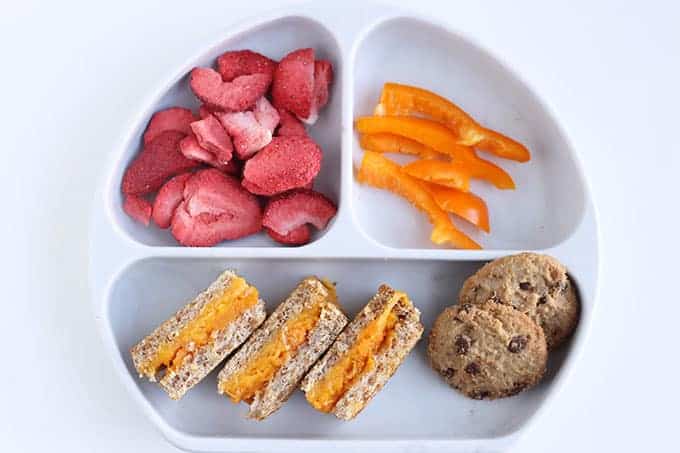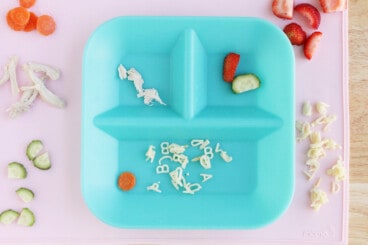Dessert for Kids
I know firsthand that it often seems like the kids are getting so many treats, and that they’re eating more treats than regular food. Plus, there’s the fact that desserts just taste good, so kids tend to prefer eating them to more regular foods. It makes sense, but of course it’s not very helpful when it comes time for dinner. But it can actually help to reduce the amount of time you spend negotiating and listening to fussing and obsessing if you regularly serve dessert right along with dinner.
Why Serving Dessert with Dinner Helps
“Offering dessert as part of the meal or with snacks can take some of the novelty away,” says Elizabeth Davenport, a registered dietician who works with families in her North Carolina practice. “It also allows children to tune into their cues and eat what they’re truly hungry for.” “A child who isn’t offered dessert regularly or is in a home where dessert is built up to be a ‘big treat’ may initially eat the dessert first (and sometimes in a hurry) when it’s offered at a meal or snack,” she explains. “A child who is offered it regularly might eat the cookie or mini cupcake first or they might take a few bites of the cookie, put it down, and take a few bites of another part of their dinner.” Think about what you want your family’s relationship with dessert to look like, and then come up with a loose structure that will foster that. Feeding therapist Ellyn Satter (who’s behind the Division of Responsibility) recommends offering one child-size serving of dessert with other foods so all foods are on the plate at the same time and are treated the same way. If you serve dessert this way every night, it may make sense to limit kids to that one serving, so the dessert food doesn’t steal too much focus from the rest of the meal. (Note that “child-size” may mean different things to different people so it’s important to not aim to be overly restrictive with the portion since the kids may realize that the amount is very small if it’s less than they’d usually see.) “If a child says they’re still hungry, you can ask them if they’d like more of dinner,” Elizabeth says. “Or if you serve the dessert after dinner has been put away, offer something else like yogurt and fruit or a bowl of cereal to round things out.”
This Isn’t About Getting Kids to Eat Less
But this isn’t about limiting kids’ treats; it’s because dessert foods tend to be easier to learn to like than other foods, and we want to make sure they’re getting plenty of learning opportunities across the board. The key is to serve the dessert right alongside the other foods so it’s an equal part of the meal. It may seem strange to put a cookie next to the Brussels sprouts, but when you do this, you’re telling your child that these foods are morally equivalent—and that she’s not good or bad for liking one over the other. That frees her up to explore them on her own terms, without worrying about pleasing you or earning credit. (This also works at snack time, when you could pair M&Ms with milk and fruit or chips with hummus and cucumbers.) But remember: On any given day, your kids may not eat equal amounts of each food and that is OK.
Why Dessert Shouldn’t Be Used as a Reward
From everything I know, it’s not very helpful to use dessert as a reward for eating dinner because nobody needs to “earn” the right to eat a food they love. Plus, a famous study by nutrition researcher Leann Birch showed that when children were pressured to finish their soup in order to get dessert, they eat less soup overall and liked it less than the kids who were allowed to eat dessert regardless of whether they finished the main meal.
And when we pressure kids to eat certain foods for any reason, they are less likely to eat those foods on their own later on.
So, let food be food and remember that you still get to decide which foods to serve when, but your kids will decide how much they eat of both dinner and dessert.
TIP: Find a list of fun rewards for kids here.
What counts as dessert?
I’ve often been asked what a parent should do when a child loves fruit, or how to handle it when a child treats fruit like dessert. It’s so easy to start to classify foods that our kids love that sometimes get a bad rap—including fruit because it contains sugar, “processed foods” like snack bars and crackers, and straight-up desserts like ice cream and cookies—as foods that should be limited. And while it’s important to me that I provide my kids with a range of food options each week to help them eat a variety of foods, it’s also important that I don’t restrict too many foods out of fear that they’ll like them and want to eat them. I’ve always found that the more I try to prevent my kids from eating certain foods, the more they want those foods. And that is the exact opposite of what I’m hoping to do with my goal of raising kids who feel safe and happy and confident around all sorts of foods and eating experiences. You could make a short list of what’s going to constitute dessert—maybe it’s cookies, brownies, and ice cream—and leave your kids in charge of “how much” on everything else. (Review how this works in the Division of Responsibility.) You’ll still want to provide some regular occasions when the kids get to have their fill of dessert without you limiting it to one serving. This might look like baking cookies together on a weekend afternoon, and then enjoying as many as you want while they are warm from the oven. Or letting them make their own sundaes with all the crazy toppings they can imagine. This is important because it lets them practice self-regulation around these foods and reduces food fixations—and getting to eat your fill of delicious brownies or ice cream is also just one of the best parts of being human! PS: I tend to ignore treats for toddlers under 2 or until they start to be aware that these foods exist. The time will naturally come and until then, there’s no real need to force or offer sweets unless you want to. I’d love to hear your thoughts on this, so please comment below to ask questions or to share your thoughts!
Toddler Not Eating? Here’s What’s Normal and What’s Not
Healthy Fat Foods (and Why We Need Them)
Growth Chart Percentiles: What They Mean, What They Don’t
Sample Daily Toddler Meal Plan (And Feeding Schedules)




